In the 1920s, the United States was rollicking with flappers, automobiles, radio and other technological innovations, Al Capone and organized crime, Louis Armstrong, John Philip Sousa, Charles Ives, and much more. This time of boom, followed by an economic crash and then World War I, defined the culture of 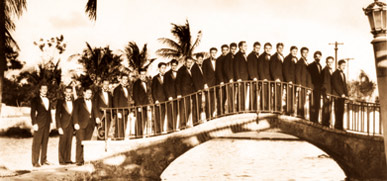 Miami and its promoters – especially real estate visionary George E. Merrick, the founder of the City of Coral Gables. South Florida’s land boom climaxed in the mid-1920s, as Merrick was bringing his plans for the new city of Coral Gables to fruition. Right from the beginning, his planned community would contain a private university that would attract northerners and serve as a bridge to the Caribbean and Central and South America.
Miami and its promoters – especially real estate visionary George E. Merrick, the founder of the City of Coral Gables. South Florida’s land boom climaxed in the mid-1920s, as Merrick was bringing his plans for the new city of Coral Gables to fruition. Right from the beginning, his planned community would contain a private university that would attract northerners and serve as a bridge to the Caribbean and Central and South America.
One of Merrick’s backers, James Cash Penney, pledged $200,000 toward a school of music in honor of his wife, Mary Kimble Penney. Part of that gift was to be $75,000 to endow a professorship, to be used as an inducement to hire Bertha M. Foster, a graduate of the Cincinnati College of Music, to bring her Miami Conservatory into the new university project. Foster agreed, and the planning started. However, on September 17, 1926, catastrophe struck. A devastating hurricane hit the city, and Coral Gables and the new university were in shambles before they even had a chance to begin.
Foster’s hopes and dreams for a school of music at the new University of Miami faced not only the usual problems inherent in human ventures but now she had to deal with a blow from nature. Merrick went broke and J.C. Penney’s pledge for the fledgling school of music turned to dust in the wind and took Foster’s endowed chair along with it.



 Miami and its promoters – especially real estate visionary George E. Merrick, the founder of the City of Coral Gables. South Florida’s land boom climaxed in the mid-1920s, as Merrick was bringing his plans for the new city of Coral Gables to fruition. Right from the beginning, his planned community would contain a private university that would attract northerners and serve as a bridge to the Caribbean and Central and South America.
Miami and its promoters – especially real estate visionary George E. Merrick, the founder of the City of Coral Gables. South Florida’s land boom climaxed in the mid-1920s, as Merrick was bringing his plans for the new city of Coral Gables to fruition. Right from the beginning, his planned community would contain a private university that would attract northerners and serve as a bridge to the Caribbean and Central and South America. 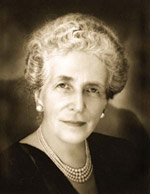 Not to be discouraged, Foster and 22 faculty members and 25 college music majors began classes just one month later, on October 15, 1926, in the old Anastasia Hotel, which had been recently remodeled to become the temporary home of the University of Miami. The Anastasia Building, as it came to be known, was the first of many so-called temporary buildings on campus whose term of service went on for a decade or more. Bowman F. Ashe was the first president of the University of Miami. He remained president for over a quarter-century and was a kindred spirit to the indomitable Foster. Ashe and Foster were the two pillars on which the University of Miami began its existence and on which its fate rested for many years thereafter.
Not to be discouraged, Foster and 22 faculty members and 25 college music majors began classes just one month later, on October 15, 1926, in the old Anastasia Hotel, which had been recently remodeled to become the temporary home of the University of Miami. The Anastasia Building, as it came to be known, was the first of many so-called temporary buildings on campus whose term of service went on for a decade or more. Bowman F. Ashe was the first president of the University of Miami. He remained president for over a quarter-century and was a kindred spirit to the indomitable Foster. Ashe and Foster were the two pillars on which the University of Miami began its existence and on which its fate rested for many years thereafter. 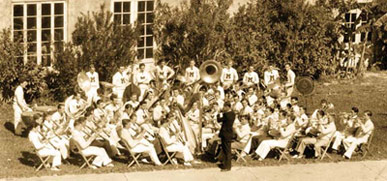 the School’s stars during the later years of the Depression was Carl Ruggles, who taught composition from 1938 to 1943. Ruggles was a noted composer of ultra-modern music who came to Miami to visit his son, a University of Miami student and ended up staying to teach for five years. He wrote several arrangements for the University Band and six brass students performed one of his original works, Angels, at a University Band concert in April 1939, the same year the School became an accredited member of the National Association of Schools of Music.
the School’s stars during the later years of the Depression was Carl Ruggles, who taught composition from 1938 to 1943. Ruggles was a noted composer of ultra-modern music who came to Miami to visit his son, a University of Miami student and ended up staying to teach for five years. He wrote several arrangements for the University Band and six brass students performed one of his original works, Angels, at a University Band concert in April 1939, the same year the School became an accredited member of the National Association of Schools of Music.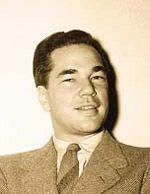
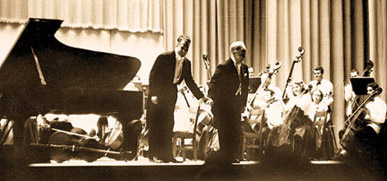 Fillmore Hall, dedicated in 1959, was a result of his dedication and generosity. In the late 1940s and early 1950s, radio and recordings were having an impact on music at the University of Miami. Station WLRD began to broadcast the University of Miami's Symphony Orchestra’s nightly performances in the University cafeteria. In addition, the music education program grew and by the mid-1950s, the School of Music boasted a local chapter of the Music Educators National Conference.
Fillmore Hall, dedicated in 1959, was a result of his dedication and generosity. In the late 1940s and early 1950s, radio and recordings were having an impact on music at the University of Miami. Station WLRD began to broadcast the University of Miami's Symphony Orchestra’s nightly performances in the University cafeteria. In addition, the music education program grew and by the mid-1950s, the School of Music boasted a local chapter of the Music Educators National Conference.